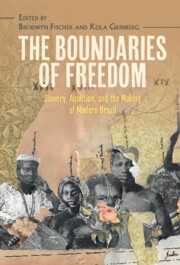Book contents
- The Boundaries of Freedom
- Afro-Latin America
- The Boundaries of Freedom
- Copyright page
- Contents
- Figures
- Tables
- Acknowledgments
- Introduction Slavery and Freedom in Nineteenth-Century Brazil
- Part I Law, Precarity, and Affective Economies during Brazil’s Slave Empire
- Part II Bounded Emancipations
- Part III Racial Silence and Black Intellectual Subjectivities
- Part IV Afterlives of Slavery, Afterwards of Abolition
- Bibliography
- Index
Introduction - Slavery and Freedom in Nineteenth-Century Brazil
- The Boundaries of Freedom
- Afro-Latin America
- The Boundaries of Freedom
- Copyright page
- Contents
- Figures
- Tables
- Acknowledgments
- Introduction Slavery and Freedom in Nineteenth-Century Brazil
- Part I Law, Precarity, and Affective Economies during Brazil’s Slave Empire
- Part II Bounded Emancipations
- Part III Racial Silence and Black Intellectual Subjectivities
- Part IV Afterlives of Slavery, Afterwards of Abolition
- Bibliography
- Index
Summary
With these words, Brazilian novelist Joaquim Maria Machado de Assis described May 13, 1888, the day that ended legalized slavery in his country. Brazil was the last nation in the Western hemisphere to abolish slavery; it had also been the largest and the most enduring slave society in the Americas. For more than 350 years, from the arrival of the first enslaved Africans in the early sixteenth century until abolition, slavery shaped Brazilian history across nearly every region of its continental geography. Over those centuries, nearly five million enslaved Africans arrived in Brazil, more than 45 percent of the total number of persons forcibly brought to the Americas. In the years that followed that sunny May 13 of abolition, Machado de Assis himself would be witness to the brevity of its joy and to the immense challenges of Brazilian freedom. The scale of those challenges was such that, a scant decade after abolition, Machado de Assis’ friend Joaquim Nabuco would write: “Slavery will long remain Brazil’s defining national feature.” Well over a century later, the power of those words persists: slavery and its legacies remain Brazil’s most formative elements.
- Type
- Chapter
- Information
- The Boundaries of FreedomSlavery, Abolition, and the Making of Modern Brazil, pp. 1 - 32Publisher: Cambridge University PressPrint publication year: 2022
- 2
- Cited by

